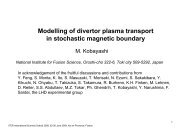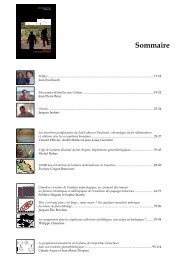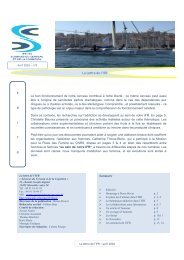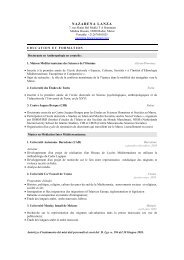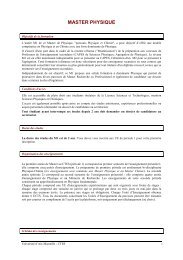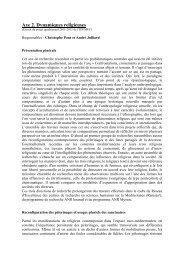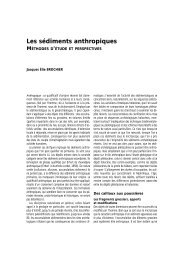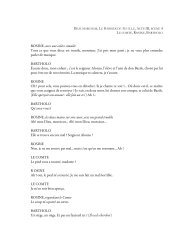sense tagging: don't look for the meaning but for the use
sense tagging: don't look for the meaning but for the use
sense tagging: don't look for the meaning but for the use
You also want an ePaper? Increase the reach of your titles
YUMPU automatically turns print PDFs into web optimized ePapers that Google loves.
and annotators were asked to mark <strong>the</strong> <strong>sense</strong>s inadditional columns. They had <strong>the</strong>re<strong>for</strong>e alloccurrences of <strong>the</strong> same word available on <strong>the</strong>screen. They could mark <strong>the</strong>m in any order, andrevise <strong>the</strong>ir judgement as <strong>the</strong>y were going along.Annotators were instructed to chose ei<strong>the</strong>r one<strong>sense</strong>, or several if <strong>the</strong>y felt that more than onewere appropriate in <strong>the</strong> given context. They couldalso choose no <strong>sense</strong> at all, if <strong>the</strong>y felt that no<strong>sense</strong> in <strong>the</strong> dictionary was appropriate in <strong>the</strong>context. In <strong>the</strong> latter case, <strong>the</strong>y were instructed towrite down a question mark in <strong>the</strong> <strong>sense</strong> column.In <strong>the</strong> subsequent study, <strong>the</strong> question mark wastreated as an additional <strong>sense</strong> <strong>for</strong> each word,grouping all <strong>meaning</strong>s that were not found in <strong>the</strong>dictionary.3.3. ResultsThe annotators gave more <strong>sense</strong>s per context <strong>for</strong>verbs than <strong>for</strong> adjectives and nouns (Table 3,column Nsen). This is likely to be a result of <strong>the</strong>larger number of <strong>sense</strong>s offered <strong>for</strong> verbs in <strong>the</strong>dictionary (see discussion above and Table 2). Theaverage number of <strong>sense</strong>s (<strong>use</strong>d by a single judgein a given context) per POS category is not veryhigh, which shows that annotators have a tendencyto avoid multiple answers (as said above, <strong>the</strong> “no<strong>sense</strong>” answer is counted as a special <strong>sense</strong>).However, <strong>the</strong> average per POS category masksimportant differences between words: <strong>the</strong> averagenumber of responses per word ranges from 1 to to1.311 (verb comprendre). In some cases,annotators <strong>use</strong>d up to six <strong>sense</strong>s in a singleresponse <strong>for</strong> a given context.Agreement was computed according to severalmeasures (summarised in Table 3):(1) Full agreement among <strong>the</strong> six annotators.Two variants were computed:MinMaxCounts agreement when judges agree on all <strong>sense</strong>sproposed <strong>for</strong> a given contextCounts agreement when judges agree on at leastone of <strong>the</strong> <strong>sense</strong>s proposed <strong>for</strong> a given contextThe difference between <strong>the</strong> min and max measuresis not very important, apart from <strong>for</strong> a few words(sûr, comprendre, importer). This is due to <strong>the</strong>fact that <strong>the</strong> average number of <strong>sense</strong>s given byjudges is close to 1 (Table 3, column Nsen). Ofcourse, <strong>the</strong>se measures are biased with <strong>the</strong> numberof judges, as mentioned above. It is howeverstriking to note that <strong>for</strong> some words (correct,historique, économie, comprendre) <strong>the</strong>re was fullagreement on none of <strong>the</strong> contexts <strong>for</strong> that word.(2) Pairwise agreement. Three variants werecomputed:MinMaxWeightedCounts agreement when judges agree on all <strong>sense</strong>sproposed <strong>for</strong> a given contextCounts agreement when judges agree on at leastone of <strong>the</strong> <strong>sense</strong>s proposed <strong>for</strong> a given contextAccounts <strong>for</strong> partial agreement using <strong>the</strong> Dicecoefficient:A∩BDice = 2A + BAgain, <strong>the</strong>re is not much difference between <strong>the</strong>measures, apart from <strong>for</strong> a few words,interestingly enough not exactly <strong>the</strong> same asbe<strong>for</strong>e (chef, comprendre, connaître).(3) Agreement corrected <strong>for</strong> chance. Themeasures above are not completely satisfactory,beca<strong>use</strong> <strong>the</strong>y do not enable comparison ofobserved agreement and agreement that would beobtained by pure chance. The κ statisticsmentioned above enables such a comparison. Inorder to account <strong>for</strong> partial agreement, κ wascomputed on <strong>the</strong> weighted pairwise measure using<strong>the</strong> extension proposed in [8].It is interesting to note that κ ranges between 0.92(noun détention) and 0.007 (adjective correct). Ino<strong>the</strong>r terms, <strong>the</strong>re is no more agreement thanchance <strong>for</strong> some words. The average κ values arelow, below 50%, which indicates a great amountof disagreement among judges.FullPairwisePOS Nsen min max min max wgh κA 1.013 0.43 0.46 0.69 0.72 0.71 0.41N 1.009 0.44 0.45 0.72 0.74 0.73 0.46V 1.045 0.29 0.34 0.60 0.65 0.63 0.41Table 3. Agreement measures per POS catagoryIt is possible that <strong>the</strong> <strong>sense</strong> divisions contained indictionaries are too fine-grained <strong>for</strong> NLP purposes.This argument has been made many times, andmany WSD systems have been restricted tohomograph level or broad <strong>sense</strong> distinctions.In order to test this hypo<strong>the</strong>sis, I have computed<strong>the</strong> degree of inter-annotator agreement when <strong>the</strong>irresponses are reduced to <strong>the</strong> top-level distinctionsmade in <strong>the</strong> dictionary (French dictionaries aremuch more hierarchical than English ones, due todifferent lexicographic traditions). The4



